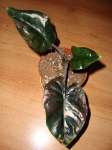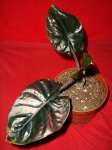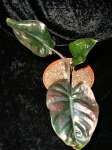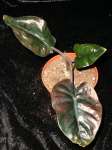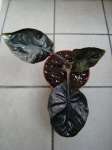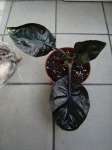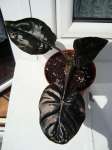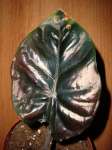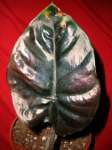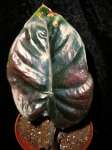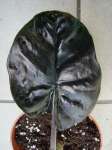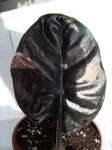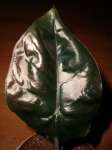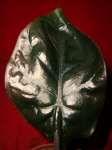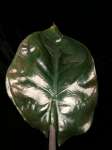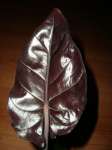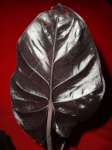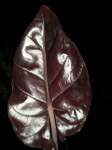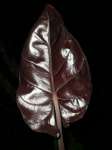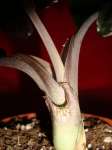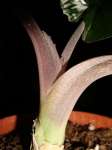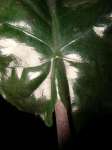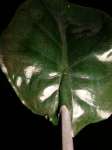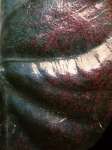 IAS on Facebook IAS on Facebook
 IAS on Instagram IAS on Instagram

|

IAS Aroid Quasi Forum
About Aroid-L
This is a continuously updated archive of the Aroid-L mailing list in a forum format - not an actual Forum. If you want to post, you will still need to register for the Aroid-L mailing list and send your postings by e-mail for moderation in the normal way.
|
Alocasia 'Black Magic'
|
From: "Marek Argent" <abri1973 at wp.pl>
on 2010.04.23 at 21:42:13(20905)
Dear Friends,
I have bought a small Alocasia with a trade name 'Black Magic'.
It is very small now, the largest leaf blade is 14 cm.
I append photos of this plant taken with and without flashlight.
When photographed with flash the leaf surface reflects red.
It also reflects red when it is disposed to direct sunlight.
There are red cells(?) not visible under low light.
The adaxial leaf surface is very dark green, almost black,
the abaxial is maroon brown, petioles are light brown
with lighter longitudinal dots 1x2 mm.
The peltate leaf base wraps the petiole.
Do you think it is a species?
How large does it grow?
I attach photos taken using various lighting.
Best,
Marek Argent
| +More | |
------=_NextPart_001_00D4_01CAE33E.994628F0
_______________________________________________
Aroid-L mailing list
Aroid-L@www.gizmoworks.com
http://www.gizmoworks.com/mailman/listinfo/aroid-l
------=_NextPart_000_00D3_01CAE33E.994628F0--
|
| |
|
From: "Sherry Gates" <TheTropix at msn.com>
on 2010.04.24 at 06:00:00(20909)
Hi Marek,
The plant in the photo looks more like Alocasia plumbea negro (a.k.a.
A. Metallica). You'll find it sold under both names. The A. Black Magic
that I've seen & grown have more of a velvety appearance to the leaves.
The leaves didn't have that coppery undertone, it would be more of a
dark blue, but not necessarily when held up to a light.
Happy growing everyone,
Sherry
| +More |
----- Original Message -----
From: Marek Argent
To: Discussion of aroids
Sent: Friday, April 23, 2010 4:42 PM
Subject: [Aroid-l] Alocasia 'Black Magic'
Dear Friends,
I have bought a small Alocasia with a trade name 'Black Magic'.
It is very small now, the largest leaf blade is 14 cm.
I append photos of this plant taken with and without flashlight.
When photographed with flash the leaf surface reflects red.
It also reflects red when it is disposed to direct sunlight.
There are red cells(?) not visible under low light.
The adaxial leaf surface is very dark green, almost black,
the abaxial is maroon brown, petioles are light brown
with lighter longitudinal dots 1x2 mm.
The peltate leaf base wraps the petiole.
Do you think it is a species?
How large does it grow?
I attach photos taken using various lighting.
Best,
Marek Argent
_______________________________________________
Aroid-L mailing list
Aroid-L@www.gizmoworks.com
http://www.gizmoworks.com/mailman/listinfo/aroid-l
------=_NextPart_000_0079_01CAE349.779A7750
_______________________________________________
Aroid-L mailing list
Aroid-L@www.gizmoworks.com
http://www.gizmoworks.com/mailman/listinfo/aroid-l
--==============�94419014845346660==--
|
|
From: Michael Pascall <mickpascall at hotmail.com>
on 2010.04.24 at 06:10:57(20910)
This is the infernal hard to grow species Alocasia infernalis .
Michael Pascall
| +More |
_________________________________________________________________
Browse profiles for FREE! Meet local singles online.
http://clk.atdmt.com/NMN/go/150855801/direct/01/
--_10bb8bf9-85a8-4d62-a834-eb905d3f2286_
_______________________________________________
Aroid-L mailing list
Aroid-L@www.gizmoworks.com
http://www.gizmoworks.com/mailman/listinfo/aroid-l
--==============C16375946302171277==--
|
|
From: Michael Pascall <mickpascall at hotmail.com> on 2010.04.24 at 06:10:57(20911)
This is the infernal hard to grow species Alocasia infernalis .
Michael Pascall,
| HTML +More |
Meet local singles online. Browse profiles for FREE!--_10bb8bf9-85a8-4d62-a834-eb905d3f2286_----==============C16375946302171277=� |
|
From: Peter Boyce <phymatarum at googlemail.com>
on 2010.04.24 at 08:49:26(20913)
Hi Marek,
This is not A. 'Black Magic' (= A. reginula A.Hay) but rather Alocasia
infernalis P.C.Boyce
Best as ever
Peter
| +More |
From: aroid-l-bounces@www.gizmoworks.com
[mailto:aroid-l-bounces@www.gizmoworks.com] On Behalf Of Marek Argent
Sent: Saturday, 24 April, 2010 5:42 AM
To: Discussion of aroids
Subject: [Aroid-l] Alocasia 'Black Magic'
Dear Friends,
I have bought a small Alocasia with a trade name 'Black Magic'.
It is very small now, the largest leaf blade is 14 cm.
I append photos of this plant taken with and without flashlight.
When photographed with flash the leaf surface reflects red.
It also reflects red when it is disposed to direct sunlight.
There are red cells(?) not visible under low light.
The adaxial leaf surface is very dark green, almost black,
the abaxial is maroon brown, petioles are light brown
with lighter longitudinal dots 1x2 mm.
The peltate leaf base wraps the petiole.
Do you think it is a species?
How large does it grow?
I attach photos taken using various lighting.
Best,
Marek Argent
------=_NextPart_000_0036_01CAE3CE.1B58C110
_______________________________________________
Aroid-L mailing list
Aroid-L@www.gizmoworks.com
http://www.gizmoworks.com/mailman/listinfo/aroid-l
--==============#20852891650677837==--
|
|
From: Peter Boyce <phymatarum at googlemail.com> on 2010.04.24 at 08:49:26(20914)
Hi Marek,
This is not A. ‘Black Magic’ (= A.reginula A.Hay) but rather Alocasia infernalis P.C.Boyce
Best as ever
Peter
| HTML +More |
From: aroid-l-bounces@www.gizmoworks.com[mailto:aroid-l-bounces@www.gizmoworks.com] On Behalf Of Marek Argent
Sent: Saturday, 24 April, 2010 5:42 AM
To: Discussion of aroids
Subject: [Aroid-l] Alocasia 'Black Magic'
DearFriends,
Ihave bought a small Alocasia with a trade name 'Black Magic'.
Itis very small now, the largest leaf blade is 14 cm.
Iappend photos of this plant taken with and without flashlight.
Whenphotographed with flash the leaf surface reflects red.
Italso reflects red when it is disposed to direct sunlight.
Thereare red cells(?) not visible under low light.
Theadaxial leaf surface is very dark green, almost black,
theabaxial is maroon brown, petioles are light brown
withlighter longitudinal dots 1x2 mm.
Thepeltate leaf base wraps the petiole.
Doyou think it is a species?
Howlarge does it grow?
Iattach photos taken using various lighting.
Best,
MarekArgent
------=_NextPart_000_0036_01CAE3CE.1B58C110----==============#20852891650677837=� |
|
From: Peter Boyce <phymatarum at googlemail.com>
on 2010.04.26 at 08:58:18(20939)
Hi Michael,
Give it light!
P.
| +More |
From: aroid-l-bounces@www.gizmoworks.com
[mailto:aroid-l-bounces@www.gizmoworks.com] On Behalf Of Michael Pascall
Sent: Saturday, 24 April, 2010 2:11 PM
To: aroid-l@www.gizmoworks.com
Subject: [?? Probable Spam] Re: [Aroid-l] Alocasia 'Black Magic'
This is the infernal hard to grow species Alocasia infernalis .
Michael Pascall,
_____
Meet local singles online. Browse profiles for FREE!
------=_NextPart_000_005F_01CAE561.AD884DA0
_______________________________________________
Aroid-L mailing list
Aroid-L@www.gizmoworks.com
http://www.gizmoworks.com/mailman/listinfo/aroid-l
--==============865656094003999739==--
|
|
From: Peter Boyce <phymatarum at googlemail.com> on 2010.04.26 at 08:58:18(20940)
Hi Michael,
Give it light!
P.
| HTML +More |
From: aroid-l-bounces@www.gizmoworks.com[mailto:aroid-l-bounces@www.gizmoworks.com] On Behalf Of Michael Pascall
Sent: Saturday, 24 April, 2010 2:11 PM
To: aroid-l@www.gizmoworks.com
Subject: [?? Probable Spam] Re: [Aroid-l] Alocasia 'Black Magic'
This is the infernal hard to grow speciesAlocasia infernalis .
Michael Pascall,
Meetlocal singles online. Browse profiles for FREE!
------=_NextPart_000_005F_01CAE561.AD884DA0----==============865656094003999739=� |
|
From: "Marek Argent" <abri1973 at wp.pl>
on 2010.04.28 at 22:39:20(20976)
Dear Friends,
The Hell has come :(
My Alocasia infernalis I got a few days ago is dying.
Photo 0: When I got the plant it was in a pot with peat.
I didn't repot it, everything seemed to be fine.
The peat was very dry, so I watered it as I normally do with all aroids
and put it into
Photo 1: into my small greenhouse which once was an aquarium.
All my aroids grow very well there.
The humidity is high there, the temperature is optimal for all plants.
Many aroids which grew poorly in normal room conditions,
in this tank grow as they should. There never was any infections.
Photo 3: One day I noticed that the Alocasia's leaves
were hanging down, but still stiff.
First I thought it was receiving too much light
but when I took it out I saw that the remnant of an old petiole sheath
was rotting
The stem was rotten through
Photo 4 & 5: The stem was rotting.
Photo 6: A part that remained in the pot was partially healthy, but most
of roots were also rotten.
Photo 7: In the soil I found a few healthy tubercles (offsets), some of
them with healthy roots
There were also small (about 1mm long) black fly-like insects in the
soil
Photo 8, 9, 10 - I cleaned the dead matter to the healthy tissue
and treated with a fungicide and rooting accelerator (?) - some kind of
powder, 2 in 1
Photo 11 - I put all parts into new soil without watering,
in one pot the small tubers, in other the bottom of the plant and in
other the top,
and I put all back to the tank.
Now questions:
Is there any chance for the plant parts to recover in such conditions
(no watering, high air humidity)?
Could the larvae of those small "flies" living in the soil eat roots?
May I water the tubercles? They are all healthy, I don't know how long
it takes to start growing, but I remember when repotting Alocasia wentii
there were many offsets in the soil every year, but only one of them
produced a leaf after a long time.
If you know any other infernal spells to rescue the plant, everything is
welcome.
Please help
Marek Argent
| +More |
----- Original Message -----
From: Michael Pascall
To: aroid-l@www.gizmoworks.com
Sent: Saturday, April 24, 2010 8:10 AM
Subject: Re: [Aroid-l] Alocasia 'Black Magic'
This is the infernal hard to grow species Alocasia infernalis .
Michael Pascall,
-------------------------------------------------------------------------
-----
Meet local singles online. Browse profiles for FREE!
-------------------------------------------------------------------------
-----
_______________________________________________
Aroid-L mailing list
Aroid-L@www.gizmoworks.com
http://www.gizmoworks.com/mailman/listinfo/aroid-l
-------------------------------------------------------------------------
-----
Nie znaleziono virusa w tej wiadomosci przychodzacej.
Sprawdzone przez AVG - www.avg.com
Wersja: 8.5.437 / Baza danych wirus�w: 271.1.1/2833 - Data wydania:
04/24/10 18:31:00
------=_NextPart_001_02CA_01CAE734.680823C0
_______________________________________________
Aroid-L mailing list
Aroid-L@www.gizmoworks.com
http://www.gizmoworks.com/mailman/listinfo/aroid-l
------=_NextPart_000_02C9_01CAE734.680823C0--
|
|
From: "Marek Argent" <abri1973 at wp.pl> on 2010.04.28 at 22:39:20(20977)
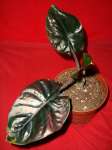
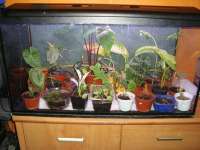
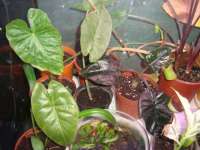
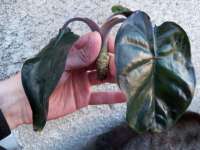
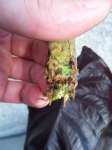
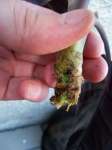
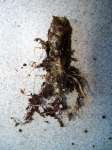
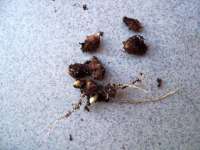
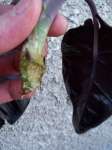
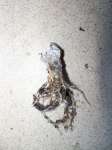
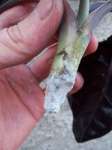
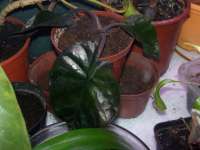
Dear Friends,
The Hell has come :(
My Alocasia infernalis I got a few days ago is dying.
Photo 0: When I got the plant it was in a pot with peat.
I didn't repot it, everything seemed to be fine.
The peat was very dry, so I watered it as I normally do with all aroids
and put it into
Photo 1: into my small greenhouse which once was an aquarium.
All my aroids grow very well there.
The humidity is high there, the temperature is optimal for all plants.
Many aroids which grew poorly in normal room conditions,
in this tank grow as they should. There never was any infections.
Photo 3: One day I noticed that the Alocasia's leaves
were hanging down, but still stiff.
First I thought it was receiving too much light
but when I took it out I saw that the remnant of an old petiole sheath was rotting
The stem was rotten through
Photo 4 & 5: The stem was rotting.
Photo 6: A part that remained in the pot was partially healthy, but most of roots were also rotten.
Photo 7: In the soil I found a few healthy tubercles (offsets), some of them with healthy roots
There were also small (about 1mm long) black fly-like insects in the soil
Photo 8, 9, 10 - I cleaned the dead matter to the healthy tissue
and treated with a fungicide and rooting accelerator (?) - some kind of powder, 2 in 1
Photo 11 - I put all parts into new soil without watering,
in one pot the small tubers, in other the bottom of the plant and in other the top,
and I put all back to the tank.
Now questions:
Is there any chance for the plant parts to recover in such conditions (no watering, high air humidity)?
Could the larvae of those small "flies" living in the soil eat roots?
May I water the tubercles? They are all healthy, I don't know how long it takes to start growing, but I remember when repotting Alocasia wentii there were many offsets in the soil every year, but only one of them produced a leaf after a long time.
If you know any other infernal spells to rescue the plant, everything is welcome.
Please help
Marek Argent
| HTML +More | |
----- Original Message -----
From: Michael Pascall
To: aroid-l@www.gizmoworks.com
Sent: Saturday, April 24, 2010 8:10 AM
Subject: Re: [Aroid-l] Alocasia 'Black Magic'
This is the infernal hard to grow species Alocasia infernalis .
Michael Pascall,
Meet local singles online. Browse profiles for FREE!
_______________________________________________
Aroid-L mailing list
Aroid-L@www.gizmoworks.com
http://www.gizmoworks.com/mailman/listinfo/aroid-l
Nie znaleziono virusa w tej wiadomosci przychodzacej.
Sprawdzone przez AVG - www.avg.com
Wersja: 8.5.437 / Baza danych wirus�w: 271.1.1/2833 - Data wydania: 04/24/10 18:31:00
------=_NextPart_001_02CA_01CAE734.680823C0--------=_NextPart_000_02C9_01CAE734.680823C0 |
|
From: Ferenc Lengyel <feri.lengyel at gmail.com>
on 2010.04.29 at 09:33:33(20978)
Marek,
I am very sorry for your plant. I have no experience with this Alocasia, but
if I were you, I would put one of the tubercules in a tray filled loosely
with cleaned coconut peat, mist it and put it in a transparent bag with the
top slightly open and mist it regularly to keep it slightlz moist. In this
setup, air movement is provided by the open top of the bag.
The small insects must be fungus gnats. Here in Hungary they are belived to
be a pest for plants in too moist conditions. But I personally think (and
English speaking pages reinforce me) that they eat fungus and rotting roots,
tubers, but not healthy ones. Though their presence indicates that there is
some problem with your plant and adult can spread fungus spores. I think,
you did the right thing. Just my opinion.
Ferenc
| +More | |
--001485e7257af9ba2604855cd11b
_______________________________________________
Aroid-L mailing list
Aroid-L@www.gizmoworks.com
http://www.gizmoworks.com/mailman/listinfo/aroid-l
--==============�94467377565043450==--
|
|
From: Ferenc Lengyel <feri.lengyel at gmail.com> on 2010.04.29 at 09:33:33(20979)
Marek,
I am very sorry for your plant. I have no experience with this Alocasia, but if I were you, I would put one of the tubercules in a tray filled loosely with cleaned coconut peat, mist it and put it in a transparent bag with the top slightly open and mist it regularly to keep it slightlz moist. In this setup, air movement is provided by the open top of the bag.
The small insects must be fungus gnats. Here in Hungary they are belived to be a pest for plants in too moist conditions. But I personally think (and English speaking pages reinforce me) that they eat fungus and rotting roots, tubers, but not healthy ones. Though their presence indicates that there is some problem with your plant and adult can spread fungus spores. I think, you did the right thing. Just my opinion.
Ferenc
| HTML +More | |
--001485e7257af9ba2604855cd11b----==============�94467377565043450=� |
|
From: "Marek Argent" <abri1973 at wp.pl>
on 2010.04.30 at 01:14:08(20985)
Dear Ferenc,
I haven't heard about such insects, but I think there's no need to put
the transparent bag on it.
The air humidity in the greenhouse is very high. This is a normal
aquarium with a plastic cover.
Marek
| +More |
----- Original Message -----
From: Ferenc Lengyel
To: Discussion of aroids
Sent: Thursday, April 29, 2010 11:33 AM
Subject: Re: [Aroid-l] Alocasia 'Black Magic'
Marek,
I am very sorry for your plant. I have no experience with this
Alocasia, but if I were you, I would put one of the tubercules in a tray
filled loosely with cleaned coconut peat, mist it and put it in a
transparent bag with the top slightly open and mist it regularly to keep
it slightlz moist. In this setup, air movement is provided by the open
top of the bag.
The small insects must be fungus gnats. Here in Hungary they are
belived to be a pest for plants in too moist conditions. But I
personally think (and English speaking pages reinforce me) that they eat
fungus and rotting roots, tubers, but not healthy ones. Though their
presence indicates that there is some problem with your plant and adult
can spread fungus spores. I think, you did the right thing. Just my
opinion.
Ferenc
-------------------------------------------------------------------------
-----
_______________________________________________
Aroid-L mailing list
Aroid-L@www.gizmoworks.com
http://www.gizmoworks.com/mailman/listinfo/aroid-l
-------------------------------------------------------------------------
-----
Nie znaleziono virusa w tej wiadomosci przychodzacej.
Sprawdzone przez AVG - www.avg.com
Wersja: 8.5.437 / Baza danych wirus�w: 271.1.1/2841 - Data wydania:
04/28/10 18:27:00
------=_NextPart_000_02E5_01CAE813.32806B60
_______________________________________________
Aroid-L mailing list
Aroid-L@www.gizmoworks.com
http://www.gizmoworks.com/mailman/listinfo/aroid-l
--==============�40852887215179346==--
|
|
From: Ferenc Lengyel <feri.lengyel at gmail.com>
on 2010.04.30 at 06:13:00(20991)
Well, yes, in a florarium you do not need the plastic bag :) But let it
get enough air movement. And I would use pure coconut peat. I found coconut
peat (or chips? I guess they are the same) to have better water retaining
capability then regular peat. I mean that peat can be very sloggy, but it
can dry out quite quickly and thorroughly. And once it has dried out, it is
not so easy to moisten it again. In a florarium drying is not an issue, but
it is harder for seeds and tubers to breath in peat then in coconut chips (I
think). In contrast, coconut chips do not get so sluggy if overwatered, they
do dry out much slower than peat and it is much easier to moisten them when
dried out. At least, it is my experience.
When your small tubers develop roots and begin to grow, put them into a
loose soil mixture of course.
I always have fungus gnats, but I have no problem with them until the roots
or tubers begin to rot. I am sure that they eat the fungus and rotting
roots/tubers. I think that your problem was caused by fungi and rotting and
not by the flies, but once the tubers begin to rot, the fly larvae make it
worse. Again: *just my opinion*.
I wonder, what others think.
Good luck for the small tubers!!!
Ferenc
| +More | |
--00c09f8c1cb09c47ad04856e2206
_______________________________________________
Aroid-L mailing list
Aroid-L@www.gizmoworks.com
http://www.gizmoworks.com/mailman/listinfo/aroid-l
--==============�99927727730525675==--
|
| |
Note: this is a very old post, so no reply function is available.
|
|



